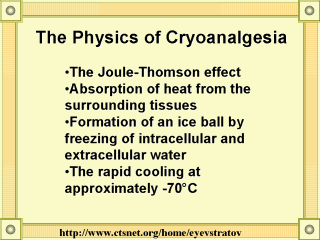 |
Modern
cryoneurolysis is based upon controlled cooling via the expansion of highly pressurized
and compressed gas (nitrous oxide or carbon dioxide) through a narrow slit aperture. Gas
under high pressure (650-800 psig) passes between the two tubes and is released through a
small orifice into the chamber of the tip of the probe. Compressed gas expands as it
passes through the orifice, resulting in a rapid decrease in temperature at the probe tip
(the Joule-Thomson effect). Absorption of heat from the surrounding tissues accompanies
gas expansion and leads to the formation of an ice ball by freezing of intracellular and
extracellular water. The rapid cooling at the tip results in temperatures of
approximately -70°C. Ice balls vary in size as a function of probe
size, freeze time, tissue permeability to water and the presence of vascular "heat
sinks." Modern cryoprobes develop ice balls . Modern insulated cryoprobes and
cryotherapy units have the ability for discriminative stimulation of sensory and motor
nerves. Locating the precise "pain generator" with nerve stimulation is
necessary because of the size of the ice ball that is generated and the need to avoid
freezing of other nontargeted tissues and nerves. Therefore, chronic painful conditions due to small localized lesions of
peripheral nerves are usual indications for cryoneurolysis. |
